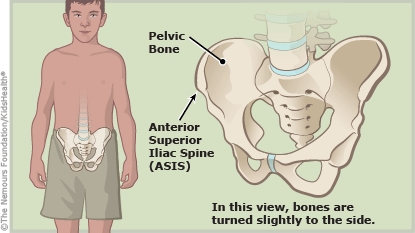The anterior superior iliac spine (ASIS) is a bump on the front of the pelvic bone. It can break when a ligament (a band of tissue that connects muscle to bone) pulls strongly on the bone and causes a small piece of it to break off. This type of fracture is called an avulsion fracture.
An ASIS fracture is treated by using crutches to rest the hip, exercises or physical therapy, and pain medicines. Most ASIS fractures heal within about 2 months. If a large piece of bone broke, surgery may be needed.


Follow your health care provider's recommendations for:
To help with pain and swelling, put cold packs wrapped in a towel over the injured area for 10–15 minutes every 3–4 hours for the first 2 days after the injury. Do not place ice directly on the skin.


Why are anterior superior iliac spine fractures more common in younger people? In adults, the anterior superior iliac spine is hardened bone. But in kids and teens, the bone is still growing and can be softer. This makes it more likely to be injured.
How does an anterior superior iliac spine fracture happen? It usually happens from a forceful movement like running, jumping, or kicking that makes the tendon pull strongly on the bone.